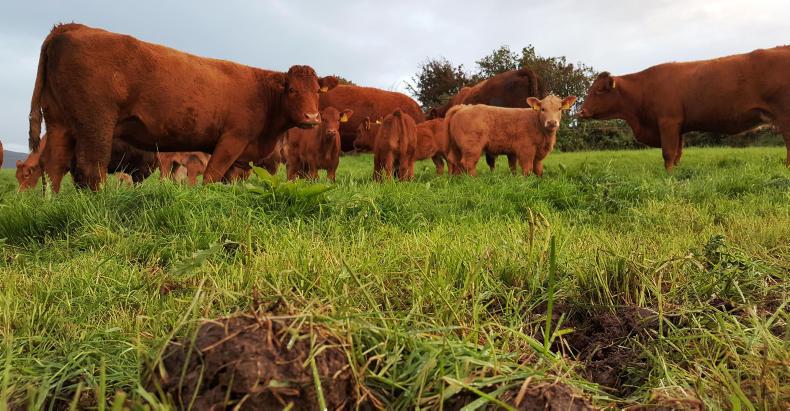The looming fodder crisis, combined with having to house stock early due to ground conditions, means many farmers will be running short of silage early in the spring.
So, what’s the solution? One option is to sell off any surplus stock, such as empty suckler cows or weanlings that would normally be sold in the spring could be offloaded now.
If these weanlings are only gaining 0.4kg or less per day over the next 100 days, farmers must ask the question is it worth feeding these stock for the winter?
Will the 40kg of additional weight cover the costs of silage and meal, as well as the slurry storage space required?
Silage quality
To know the answer to these questions, each farmer will have to know the quality of silage at their disposal – if silage is available at all – the cost of additional meal feeding and how have weanlings performed on the farm over winters past.
Teagasc and Aurivo co-op have a role to play in assisting and advising farmers along the way and have been active in this regard running workshops and clinics to assist farmers. The next step for any farmer will be to have their silage tested and act on the results.

Cow effieciency
Longer term, there needs to be more focus and attention given to cow efficiency. Does the 800kg suckler cow produce a heavier calf compared with the 650kg cow. How much more is it costing to feed the heavier cow compared with the lighter one, particularly over the winter period.
Personally, I would prefer eight 700kg cows in a pen for the winter, rather than seven 800kg cows theoretically eating the same amount of feed overall.
Every week there are reports from various in-calf and springer heifer sales around the country and big prices being paid for three- and sometimes four-year-old heifers weighing in north of 800kg.
Nobody can blame the sellers for offering these animals for sale, because there is obviously demand among farmers for the show stoppers. Perhaps they are being bought to breed the next generation of show heifers.
Decent margins
In general, the average commercial suckler farmer looking to make a decent margin over the cost of production will need to look at a lighter continental-bred cow with good milk ability capable of producing the quality U and R grading beef animal.
Unless we do that, then there will be more fodder crises and some may decide to abandon the suckler cow altogether. That is if we are not forced to do so by some climate change activists or lobby group feeding misinformation to the likes of the Citizens Assembly.
Read more
Farmer Writes: what to do with the calf that won’t suck
Listen: fodder relief scheme for farmers
Listen: hardship taking its toll on fodder-hit farmers
The looming fodder crisis, combined with having to house stock early due to ground conditions, means many farmers will be running short of silage early in the spring.
So, what’s the solution? One option is to sell off any surplus stock, such as empty suckler cows or weanlings that would normally be sold in the spring could be offloaded now.
If these weanlings are only gaining 0.4kg or less per day over the next 100 days, farmers must ask the question is it worth feeding these stock for the winter?
Will the 40kg of additional weight cover the costs of silage and meal, as well as the slurry storage space required?
Silage quality
To know the answer to these questions, each farmer will have to know the quality of silage at their disposal – if silage is available at all – the cost of additional meal feeding and how have weanlings performed on the farm over winters past.
Teagasc and Aurivo co-op have a role to play in assisting and advising farmers along the way and have been active in this regard running workshops and clinics to assist farmers. The next step for any farmer will be to have their silage tested and act on the results.

Cow effieciency
Longer term, there needs to be more focus and attention given to cow efficiency. Does the 800kg suckler cow produce a heavier calf compared with the 650kg cow. How much more is it costing to feed the heavier cow compared with the lighter one, particularly over the winter period.
Personally, I would prefer eight 700kg cows in a pen for the winter, rather than seven 800kg cows theoretically eating the same amount of feed overall.
Every week there are reports from various in-calf and springer heifer sales around the country and big prices being paid for three- and sometimes four-year-old heifers weighing in north of 800kg.
Nobody can blame the sellers for offering these animals for sale, because there is obviously demand among farmers for the show stoppers. Perhaps they are being bought to breed the next generation of show heifers.
Decent margins
In general, the average commercial suckler farmer looking to make a decent margin over the cost of production will need to look at a lighter continental-bred cow with good milk ability capable of producing the quality U and R grading beef animal.
Unless we do that, then there will be more fodder crises and some may decide to abandon the suckler cow altogether. That is if we are not forced to do so by some climate change activists or lobby group feeding misinformation to the likes of the Citizens Assembly.
Read more
Farmer Writes: what to do with the calf that won’t suck
Listen: fodder relief scheme for farmers
Listen: hardship taking its toll on fodder-hit farmers







 This is a subscriber-only article
This is a subscriber-only article











SHARING OPTIONS: